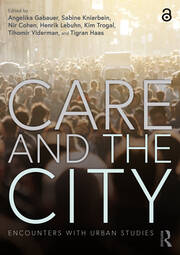Gabauer, Angelika, Sabine Knierbein, Nir Cohen, Henrik Lebuhn, Kim Trogal, Tihomir Viderman, and Tigran Haas. Care and the City: Encounters with Urban Studies. New York: Routledge, 2021. https://doi.org/10.4324/9781003031536.

Care and the City offers a broad set of interventions on the nature of care and the relevance of caring, institutions of care and spatialities of care to cities. I read it against Rinaldo Walcott’s On Property (2021) which forms a follow up to this commentary. Care is not only a way of reflecting on supportive relationships but an ethic of reciprocity that attends to the other. It is relational but has to be materialized, that is, actualized. Geographers such as Doreen Massey have critiqued the confinement of care to the domestic sphere, or to a particular community. This spatialization of care further excludes it from spaces, relations and practices of ‘uncaring’ and of carelessness, which Ali Madanipour criticizes as a noxious form of overconfidence. Uncaring typifies many economic practices – as in the comment “its not personal sonny, its just business” as the line goes in The Godfather movie (1971)
Building on the feminist politicization of care-giving as “More than a labour or love” (Meg Luxton, 1980), the contributors consider the spatiality of care regimes. Care focuses attention on relations, embodiedness, and specific sites and encounters. How does Care meet the city? A multi-scalar, micro and macro approach is needed. The urban foregrounds relations and dependencies rather than rational choice and economic interaction. The urban moves analysis out of the domestic and care that is dependent on kinship. What is the urban quality of caring? The polis, also brings care together with justice and obligation of attending to the other together with the right to the city, as we will argue in forthcoming work on ethics and aesthetics.
As the editors herald in their Introduction, this book coincides with the crisis of institutional care revealed by CoVid-19: “The more a place was affected…the more care was perceived as a shared ingredient of everyday lives. Either the presence or the absence of both traditional and more innovative forms of care…” (3). Nonetheless, the collection reflects the limitations of grasping the scope of the CoVid-19 crisis from the standpoint of affluent European societies with relatively intact social welfare and health care systems. Perhaps it is therapeutic to theorize care. In many countries, marginalized seniors, prisoners, the elderly, migrant workers lived in crowded congregate settings or jobs without the means to distance or isolate themselves to avoid infection. While care did certainly come to the forefront of attention, a prominent aspect of the CoVid-19 pandemic were failures of commodified and institutionalized care of the elderly. Like prisoners, they were subject to isolation in cells, rooms and wards, cutting them off from the city, families and social networks, even within the same buildings. Confinement and segregation give CoVid-19 a starkly spatial character – an ongoing mega-urban calamity in, for example Shanghai. Innovative forms of community caring such as collectively chanting and singing from balconies supplemented the efforts of medical professionals. But the inadequacies of commodified care put an enduring stamp on the pandemic: modernist care economies were no match for the virus, which was finally managed biotechnically by the development of vaccines and through the extinguishment of those most vulnerable.
The pandemic has been a macabre demonstration that geographies of care involve emergence and becoming-related as infected. Shanghai in 2022 illustrates how “most responses to the pandemic were dominated by ‘one-size-fits all’ policies characterized by the logic of state bureaucracies rather than..spatially sensitive strategies that would pay attention to the particular needs and risks of specific groups.” (3) which deeply impacted the quality of social relations. The pandemic elicited measures of care and uncare. This teaches us that care is about caring and attending-to as much as “taking care of”.
The result of lockdowns was widespread injustice as entire cities suffered curfews as a precautionary measure to limit the spread of contagion. The loss of freedom sparked populist political responses which changed the political climate of democracies. In Canada the “trucker occupation”, horns blaring, of the capital city, Ottawa, for over 3 weeks is one example we have dealt with (read more here and here).
The struggle with analysing care and caring is in its simultaneous both-and qualities as a gerund. The noun-verb hybrid captures care as something that requires an action (actualisation). Care is undebatably a thing, but it is not a physical object. It cannot be encapsulated by the idea of care alone; its truth does not lie in representations of care. Instead, is an intangible object, a virtuality that characterizes actions, symbols and objects. This character, this virtuality, is the realization of abstract representations of care, and this becomes obvious through the material effects of caring. But to care, care must be actualized through an action that brings it to material presence.
The contributors to this broad and accessible text wrestle with care as the hospitality and enclosure of refugees, in digital platforms, the conservation of heritage sites, and as part of maintenance and repair of both material environments and urban societies. Significantly, care and solidarity initiatives reconfigure buildings, public spaces, the city and its official infrastructure “from below”, so to speak. As Isabel Gutiérrez Sanchez shows for the case of Athens, unofficial solidarity initiatives create a geography of caring that is uneven, precarious and decentralizing. This grassroots care infrastructure is insurgent, opening up potentials and creating change; “They actually yield processes through which disposed, excluded, and/or alienated urban dwellers collectively claim and enact their right to actively participate and transform their urban environment, becoming a force of action….” (160)
- Rob Shields
